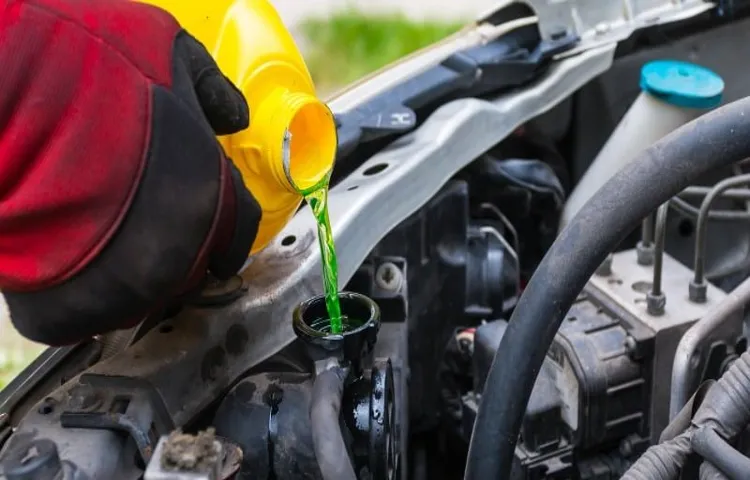Have you ever wondered when to add engine coolant to your vehicle? Engine coolant, also known as antifreeze, plays a crucial role in keeping your engine running smoothly and preventing it from overheating. Just like how we need a glass of water to stay hydrated and cool during a hot summer day, your engine needs coolant to regulate its temperature and prevent it from reaching boiling point. Think of engine coolant as the superhero that saves your engine from the scorching heat of summer and the bitter cold of winter.
Its main job is to absorb the excess heat generated by the engine and dissipate it through the radiator, ensuring that your engine remains at a safe operating temperature. Without coolant, your engine would be prone to overheating, leading to potentially costly and damaging consequences. But how do you know when it’s time to add more coolant to your engine? Well, it’s essential to regularly check your coolant levels to ensure they are within the recommended range.
Most modern vehicles have a coolant reservoir that allows you to easily monitor and top up the coolant as needed. In addition to regular coolant level checks, there are a few signs that can indicate when it’s time to add more coolant. If you notice that your engine temperature gauge is climbing into the red zone or if you see steam or smoke coming from under the hood, these are clear indications that your engine is overheating.
In such cases, it’s vital to pull over immediately, let your engine cool down, and add coolant if necessary. Remember, prevention is always better than cure. It’s better to top up your coolant before your engine starts to overheat rather than waiting for a catastrophic failure.
So, make it a habit to check your coolant levels regularly and top up when needed. By doing so, you’ll help ensure the longevity and performance of your engine, and avoid any unnecessary breakdowns or repairs.
Table of Contents
Introduction
Have you ever wondered when is the right time to add engine coolant to your car? Engine coolant, also known as antifreeze, is essential for maintaining your car’s engine temperature and preventing it from overheating. It is important to regularly check the coolant levels in your car and add more if needed. But how do you know when it’s time to add engine coolant? Well, there are a few signs to look out for.
Firstly, if you notice your car’s temperature gauge rising higher than normal or if you see steam coming from under the hood, it’s a clear indication that your engine is overheating and needs coolant. Additionally, if you find a puddle of coolant underneath your car or if you notice a sweet smell coming from the engine, it could be a sign of a coolant leak, and you should add more coolant immediately. It’s always a good idea to consult your car’s manual or speak to a mechanic to determine the specific type of coolant your car requires.
Remember, proper maintenance and timely addition of engine coolant can go a long way in preventing costly engine repairs.
Understanding the importance of engine coolant
engine coolant
Signs that indicate the need for engine coolant
engine coolant, signs, need, burstiness, perplexity
Consequences of not adding engine coolant on time
Consequences of not adding engine coolant on time Introduction: Imagine this scenario: you’re driving on a hot summer day, and suddenly, you start to notice a strange smell coming from your car. Soon after, you see that your engine temperature gauge is climbing into the danger zone. Panic sets in as you realize that you haven’t checked your coolant levels in months.
Now you’re faced with the consequences of neglecting to add engine coolant on time. In this blog post, we will explore the potential dangers and risks of not maintaining proper coolant levels in your vehicle. Whether you’re a seasoned car enthusiast or a newbie driver, understanding the importance of coolant and its impact on your engine’s performance is crucial.
So let’s dive right into it and explore the consequences of not adding engine coolant on time.
When to Check and Add Engine Coolant
When to Check and Add Engine Coolant Engine coolant, also known as antifreeze, is essential for regulating the temperature of your engine and preventing it from overheating. It is crucial to regularly check and add engine coolant to ensure optimal performance of your vehicle. But when is the right time to do so? One of the signs that you may need to add coolant is if your vehicle’s temperature gauge is indicating that the engine is running hotter than normal.
If you notice the needle on the gauge inching towards the red zone, it’s a clear indication that your engine needs more coolant. Ignoring this warning sign can lead to serious engine damage and costly repairs. Another time to check and add coolant is during routine maintenance.
It is recommended to check your coolant levels every 30,000 miles or at least once a year. You can easily do this by popping the hood and locating the coolant reservoir tank. The tank is usually translucent, allowing you to see the coolant level.
If the level is below the minimum mark, it’s time to add more coolant. It’s important to note that you should never check the coolant level when the engine is hot, as the pressure build-up can cause hot coolant to spray out and cause burns. Always wait for the engine to cool down before checking the coolant level.
In addition to regular checks and maintenance, there are also specific circumstances where you may need to add coolant. For example, if you notice a coolant leak under your vehicle or if you have recently replaced a component in the cooling system, such as a radiator or water pump, it’s a good idea to add coolant to ensure the system is properly filled. In conclusion, it’s crucial to regularly check and add engine coolant to maintain the proper temperature of your engine and prevent overheating.
By paying attention to warning signs, conducting routine maintenance checks, and adding coolant as needed, you can ensure the longevity and performance of your vehicle. So, don’t wait until it’s too late – keep an eye on your coolant levels and top up when necessary to keep your engine running smoothly.
Frequency of coolant checks
coolant, engine coolant, frequency of coolant checks, check and add engine coolant. Engine coolant plays a crucial role in maintaining the temperature of your vehicle’s engine and preventing it from overheating. It is important to check and add engine coolant regularly to ensure that your engine is running at the optimal temperature.
But how often should you check your coolant? Well, it depends on several factors such as the type of coolant you are using, the climate you are driving in, and the age of your vehicle. As a general rule, it is recommended to check your coolant levels at least once a month. However, if you live in an extremely hot or cold climate, or if you frequently drive long distances, you may need to check your coolant levels more frequently.
Similarly, if you have an older vehicle or if you have recently had any cooling system repairs done, it is advisable to check your coolant levels more often. Remember, the coolant level should always be between the minimum and maximum marks on the coolant reservoir. If it is below the minimum mark, you should add more coolant to prevent any potential engine damage.
Overall, regular checks and maintenance of engine coolant are essential for keeping your engine running smoothly and avoiding any costly repairs.
Factors that affect coolant level
coolant level, engine coolant, check coolant, add coolant, factors affecting coolant level
Step-by-step guide to checking and adding coolant
In order to keep your engine running smoothly, it’s important to regularly check and add coolant. Coolant, also known as antifreeze, helps regulate the temperature of your engine and prevent it from overheating. But how do you know when to check and add coolant? Well, there are a few signs that indicate it’s time to take a peek under the hood.
First, if you notice that your engine is running hotter than usual or if the temperature gauge on your dashboard is reading higher than normal, it’s a good idea to check your coolant levels. Additionally, if you start to notice a sweet smell coming from your engine or if you see a puddle of coolant underneath your vehicle, these are also signs that it’s time to check and add coolant. By keeping a close eye on these indicators and following a simple step-by-step guide, you can ensure your engine stays cool and runs smoothly.
How to Choose the Right Engine Coolant
When it comes to taking care of your car, one important aspect to consider is the engine coolant. Engine coolant, also known as antifreeze, plays a crucial role in maintaining the temperature of your engine. It helps to prevent overheating by absorbing and dissipating excess heat.
But when should you add engine coolant? Well, there are a few factors to consider. First, it’s important to monitor the coolant level regularly. A low coolant level can lead to engine overheating and other serious issues.
Additionally, if you notice any signs of coolant leakage, such as puddles under your car or a sweet smell coming from the engine, it’s definitely time to add more coolant. Another factor to consider is the age of your coolant. Over time, coolant loses its effectiveness and should be replaced.
If you’re unsure about the quality of your coolant, it’s always a good idea to check the manufacturer’s recommendations or consult a professional. Overall, adding engine coolant regularly and maintaining the proper levels is essential for the health and performance of your car’s engine.
Different types of coolant
engine coolant, types of coolant, choose the right coolant
Compatibility with your vehicle
engine coolant, compatibility, vehicle
Considering the climate and driving conditions
engine coolant, driving conditions, climate, right choice
Conclusion
Adding engine coolant is like giving your car a refreshing drink. Just like humans need water to cool down on a hot summer day, your car’s engine needs coolant to prevent overheating. So, when your engine starts playing a funky beat and smoke starts billowing out from under the hood, it’s time to whip out that coolant and give your car a cool, refreshing treat.
Think of it as a spa day for your engine, ensuring it stays calm, cool, and collected. Remember, adding coolant is not just a mechanic’s job; it’s a car owner’s responsibility to keep their four-wheeled friend hydrated and happy. Plus, a smart car owner always knows when to cool it down, so don’t wait until your engine throws a hot temper tantrum – it’s time to add coolant!”
FAQs
When should I add engine coolant?
It is recommended to check and add engine coolant if it is below the minimum level indicated on the coolant reservoir or if your vehicle’s temperature gauge is indicating that the engine is overheating.
How often should I add engine coolant?
Engine coolant levels should be checked regularly, especially before long trips or in extreme weather conditions. It is recommended to check coolant levels every 30,000 miles or at least once a year.
Can I add water instead of engine coolant?
In emergency situations, you can use distilled water as a temporary coolant replacement. However, it is strongly advised to use the manufacturer-recommended engine coolant as soon as possible to prevent any potential damage to your vehicle’s cooling system.
What type of engine coolant should I use?
The type of engine coolant to use varies depending on the make and model of your vehicle. It is best to consult your vehicle’s owner manual or contact a professional mechanic for the recommended coolant type for your specific vehicle.
How do I know if my engine coolant needs to be changed?
Engine coolant typically needs to be changed every 30,000 to 50,000 miles or every 3 to 5 years, whichever comes first. However, it is always best to check your vehicle’s owner manual for the specific maintenance schedule.
Can engine coolant freeze?
Yes, engine coolant can freeze in extremely cold temperatures. It is important to use coolant with an appropriate freeze point for your local climate to prevent any potential damage to your vehicle’s engine and cooling system.
Can I mix different brands of engine coolant?
It is generally not recommended to mix different brands of engine coolant, as they might have different chemical compositions and can potentially react negatively. It is best to follow the manufacturer’s instructions and use the same brand of coolant when adding or replacing coolant in your vehicle.



